
Francesco Squarcione was an Italian artist from Padua. His pupils included Andrea Mantegna, Cosimo Tura and Carlo Crivelli. There are only two works signed by him: the Madonna and Child and the Lazara Altarpiece.

Carlo Crivelli was an Italian Renaissance painter of conservative Late Gothic decorative sensibility, who spent his early years in the Veneto, where he absorbed influences from the Vivarini, Squarcione, and Mantegna. He left the Veneto by 1458 and spent most of the remainder of his career in the March of Ancona, where he developed a distinctive personal style that contrasts with that of his Venetian contemporary Giovanni Bellini.

Pietro Paolo Agabito or Agabiti (c1470-c1540) was an Italian Renaissance painter, sculptor, and architect from the Marche region. His style is rather provincial, and most surviving works are in the churches and museums of the region. He may have trained with Carlo Crivelli, and among the artists generally credited with having influenced his style are the Venetians Cima da Conegliano and Alvise Vivarini, the Bolognese artist Francesco Francia and Marco Palmezzano of Forlì. However, Agabiti did not keep up with the changes of style occurring in the early sixteenth century, remaining attached to the more formal style of the fifteenth century.

Founded in 1959, The El Paso Museum of Art (EPMA) is located in downtown El Paso, Texas. First accredited in 1972, it is the only accredited art museum within a 250-mile radius and serves approximately 100,000 visitors per year. A new building was completed in 1998. In addition to its permanent collection and special exhibitions, the museum also offers art classes, film series, lectures, concerts, storytelling sessions and other educational programs to the West Texas, Southern New Mexico and Ciudad Juarez, Mexico community.

John Graver Johnson was an American corporate lawyer and art collector. The Philadelphia law firm that he founded in 1863 continues under the name Saul Ewing. His collection of nearly 1,300 paintings forms the core of early European works at the Philadelphia Museum of Art.

Anatolian animal carpets represent a special type of pile-woven carpet, woven in the geographical region of Anatolia during the Seljuq and early Ottoman period, corresponding to the 14th–16th century. Very few animal-style carpets still exist today, and most of them are in a fragmentary state. Animal carpets were frequently depicted by Western European painters of the 14th–16th century. By comparison of the few surviving carpets with their painted counterparts, these paintings helped to establish a timeline of their production, and support our knowledge about the early Turkish carpet.

Madonna and Child with Saints and Donor is a c. 1490 oil on panel painting by Carlo Crivelli. It shows the Madonna and child between Francis of Assisi and Bernardino of Siena, with a tiny figure of the painting's donor kneeling on the balustrade in front of the Madonna. It is stored at the Walters Art Museum in Baltimore.
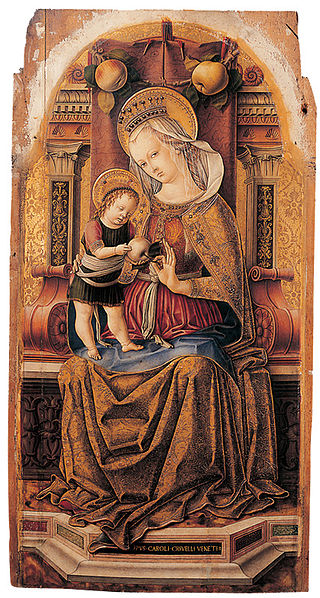
The St Peter Martyr Altarpiece or Minor San Domenico Altarpiece is a altarpiece in tempera and gold on panel by Carlo Crivelli, executed c. 1476. Its central panel of the Madonna and Child, signed "OPVS CAROLI CRIVELLI VENETI", is now in the Museum of Fine Arts in Budapest. The altarpiece's other panels were seen in Rome by Luigi Lanzi in 1789 before being moved to Florence with the Rinuccini family. In 1868 it moved from the Demidov collection to the National Gallery in London, where they still hang.

The 1476 Altarpiece or San Domenico Altarpiece is a 1476 tempera and gold on panel altarpiece by Carlo Crivelli. Its central panel of the Pietà is now in the Metropolitan Museum of Art in New York, whilst the other nine are now in the National Gallery, London.
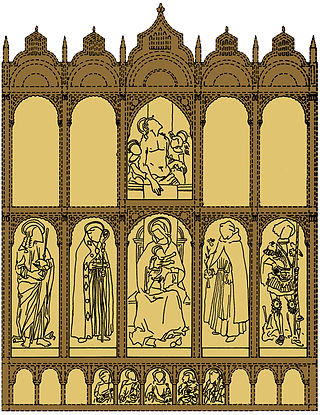
The 1472 Altarpiece was a tempera and oil on panel altarpiece by Carlo Crivelli, dated 1472 on the central panel. Also known as the Fesch Altarpiece or the Eckinson Altarpiece, it is now divided up between a number of galleries in the United States and Europe.

The Massa Fermana Altarpiece is a 1468 tempera and gold on panel by Carlo Crivelli, held in Santi Lorenzo e Silvestro church in the town of Massa Fermana. It is signed "KAROLVS CRIVELLVS VENETVS PINXIT HOC OPVS MCCCCLXVIII". It is his earliest known surviving work and is notable for dating his return to Italy.

Adoration of the Shepherds is a c. 1480 tempera and gold on panel painting by Carlo Crivelli. It is now in the Museum of Fine Arts in Strasbourg, for which it was acquired in Florence by Wilhelm von Bode. Its inventory number is 171. Art historians are uncertain about the dating of the painting, and propositions have ranged from 1470 to 1491.

Saint Francis with the Blood of Christ is a c. 1490-1495 tempera and gold on panel painting by Carlo Crivelli, signed at bottom right OPUS CAROLI CRIVELLI VENETI / MILES VERUS". On the reverse is a heraldic emblem. It is now in the Museo Poldi Pezzoli in Milan.
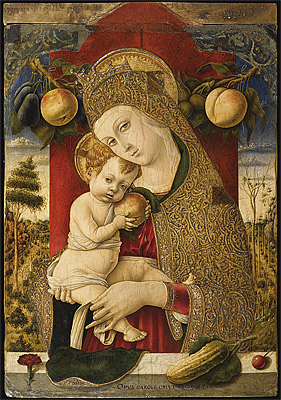
The 'Lochis Madonna is a tempera and gold on panel painting by Carlo Crivelli, executed c. 1475, and signed OPVS CAROLI CRIVELLI VENETI. It is now in the Accademia Carrara in Bergamo, which it entered in 1866 from Guglielmo Lochis' collection - its previous history is unknown.
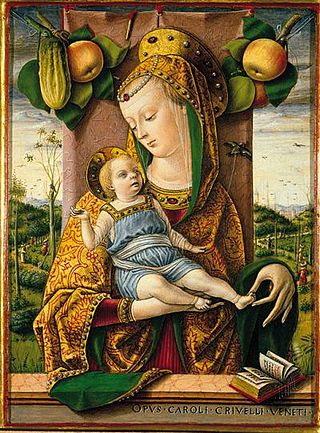
Madonna and Child is a tempera and gold on panel painting by Carlo Crivelli, executed c. 1480, and signed OPVS CAROLI CRIVELLI VENETI. It is now in the Pinacoteca civica Francesco Podesti in Ancona. Its dating has varied on stylistic grounds between the 1470s and 1480s, close in date to the artist's Lenti Madonna and Madonna and Child with an Apple.
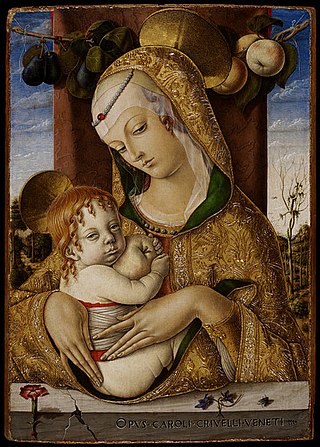
Madonna and Child with an Apple or Madonna and Child Holding an Apple is a tempera and gold on panel painting by Carlo Crivelli, executed c. 1480, now in the Victoria and Albert Museum in London, having entered it as part of the Jones collection - its previous provenance is unknown. It is signed OPVS CAROLI CRIVELLI VENETI.

The Lenti Madonna or Bache Madonna is a tempera and gold on panel painting by Carlo Crivelli, executed c. 1472–1473, and signed OPVS KAROLI CRIVELLI VENETI. It is now in the Metropolitan Museum of Art in New York, which it entered in 1944.

The Porto San Giorgio Altarpiece or Porto San Giorgio Polytpych was a 1470 multi-panel tempera and gold on panel altarpiece by Carlo Crivelli. Stylistically similar to Crivelli's Massa Fermana Altarpiece, the work was a fundamental step in his evolution away from the Paduan Renaissance towards a more delicate and realist style.
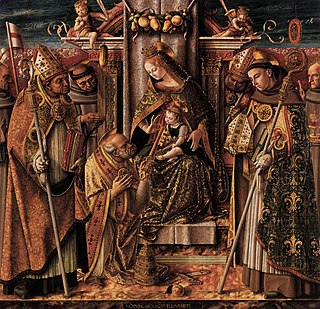
The San Pietro di Muralto Altarpiece or San Pietro degli Osservanti Altarpiece is a 1488-1489 tempera and gold on panel altarpiece by Carlo Crivelli and his studio, named after the Dominican church in Camerino in which it originally hung, and now divided between a number of American and European museums.

The San Domenico di Camerino Altarpiece is a 1482 tempera and gold on panel painting by Carlo Crivelli, probably originally painted in Camerino and now divided between the Pinacoteca di Brera, in Milan, the Stadel Museum, in Frankfurt, and the Abegg-Stockar Collection, in Zurich.




















